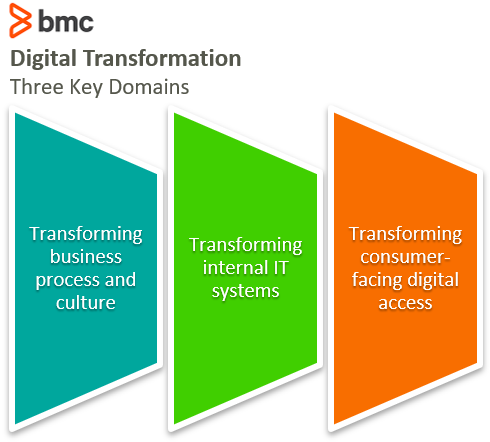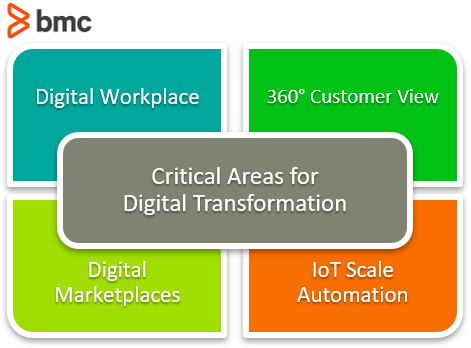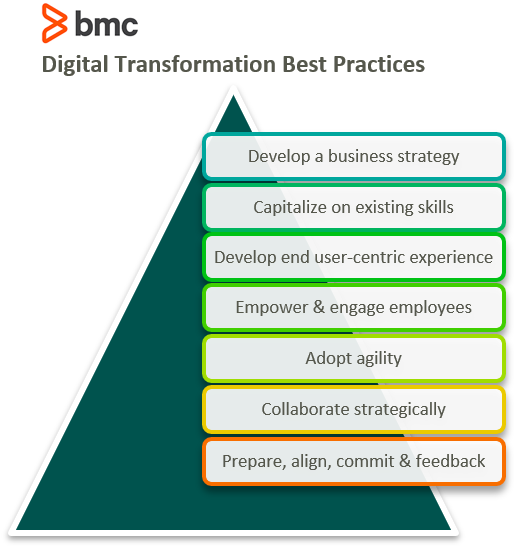Digital Transformation (DX) presents new opportunities for operational gains, business process improvements, and cultural change. In 2018, digital transformation initiatives spent $1.3 trillion globally in order to realize these opportunities. According to research, however, 70% of all digital transformation projects fail—which means $900 billion was spent without realizing true transformation!
This begs the questions: How do you define transformation? And how do you determine whether you truly transformed?
In this article, we will explore:
- What transformation means across three key domains
- DX best practices and strategy to correctly transform your business and assets
Domains of digital transformation
The scope of transformation through technology extends to three key domains:

Transforming business processes & culture
The domain of business process transformation encapsulates the changes in business processes and organizational culture. These changes are centered around the investments in digital technologies, therefore requiring strong sponsorship engagement from key stakeholders, especially top executives and end users.
The transformation must be driven by business goals that can be effectively fulfilled through the digital technology investments. The organization should have the necessary skills to take advantage of the new technologies.
Finally, you’ll need cultural change to incorporate modern frameworks and best practices guidelines such as Agile, DevOps, and other ITSM frameworks.
Transforming internal IT systems
IT systems support the deployment of new technology solutions that process existing IT workloads and data assets to provide enhanced features and functionality. The IT environment should be capable of running new digital solutions without causing issues related to technology integration, performance, or security.
As the enterprise IT industry rapidly evolves, new digital technologies may not always support your existing IT environment and systems. Some issues can turn your systems into legacy state, such as:
- Vendor lock-in
- Lack of standardization
- Limited end-of-life support
That’s why you need to thoroughly assess, and potentially overhaul, your IT systems. Running legacy apps and IT workloads on new IT systems may not be as easy as a ‘lift-and-shift’. Instead, IT transformation follows a controlled process with steps ranging as varied as:
- Baselining and benchmarking
- Implementation
- Change management
- Strong governance controls
Transforming consumer-facing digital access
Technology must be integrated across all aspects of the business, transforming the operational and business models, culture, tools, processes, and strategies. In essence, IT transformation and business process transformation are the necessary enablers to digital transformation.
Investments into digital technologies are only effective when they can deliver the intended functionality supported by the necessary IT systems, organizational culture, workforce skill set, organizational strategy, and business models. If you are missing the right tools, business drivers, or mindset, digital transformation will only magnify the flaws within your existing operational model.
The transformation across these domains enable organizations from traditional industries to find and engage a user base in a digital world. In her article on Digital Service Management, Kirstie Magowan outlines four areas that are particularly critical to transforming your consumer digital access:

Consider the case of toymaker LEGO. The company was close to bankruptcy in 2004 following a steady decline over the previous decade. At its tipping point, the company shifted its operational and business model to enable services suitable for a digital world. By 2014, the company established several revenue streams through digital channels via mobile apps, games, and movies. In 2014, the first LEGO movie generated $468 million with a budget of only $60 million.
Digital transformation strategies & best practices
The example of LEGO shows that digital transformation can yield remarkable business value through the digital channels. However, the transformation is not about digitizing existing manual experiences for internal employees or consumers. Instead, digital transformation must be guided by a broad strategy that both:
- Explores new opportunities in the digital world
- Addresses existing operational challenges through the available digital means
The following key strategies can help your organization succeed at digital transformation:

- Develop the right business strategy. Establish concrete goals for your overall digital strategy—instead of focusing investments on specific digital technologies.
- Take advantage of existing skills and human resources. External consultants may not be aware of the unique business challenges facing your organization or entirely embrace your business goals. Insider knowledge and skills can help elevate the digital transformation journey with minimal risk and HR capital.
- Develop an end-user centric digital experience. Since digital transformation success depends on end-user adoption, it’s important to get out of the building, listen to customers, and enable digital solutions that address their requirements—not yours.
- Empower and engage employees. Design internal IT and business transformation initiatives to empower the internal workforce with the necessary tools, capabilities, and a culture of engagement. Establish governance controls that facilitate the workforce, adopt frameworks that facilitate collaboration, and provide solutions that make employees’ daily job tasks easier for them.
- Adopt the agility of a fast-moving firm. Digital transformation requires organizations to move fast in response to changing market circumstances. This culture is resonant in Silicon Valley tech startups, known for their ability to pivot easily and transform their business processes to disrupt the market with innovative new digital services.
- Collaborate strategically. Partner with trusted advisors with experience in achieving successful digital transformation with organizations in similar industry verticals and business markets. These partnerships extend to technology vendors, especially in light of issues such as vendor lock-in, cost, security, support, Service Level Agreement (SLA) performance and other aspects that may limit the ability to transform IT and business processes effectively.
- Prepare, align, commit, and feedback. Finally, listen to customers and employees, keep an eye on changing market conditions, and establish a proactive approach to continual improvement. This is especially useful since digital transformation is not a static investment project—but an ongoing process of continual growth and improvement.
Additional resources
For related reading, explore these resources:
These postings are my own and do not necessarily represent BMC's position, strategies, or opinion.
See an error or have a suggestion? Please let us know by emailing blogs@bmc.com.






